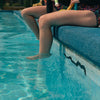

Introduction
Whether you have a luxury swimming pool or a simple inflatable kiddie pool: a clean and safe pool starts with proper maintenance. Many people focus mainly on keeping the water clear but overlook one important issue – slippery edges and floors. These pose a serious risk for slips and falls, especially for children. In this blog, you’ll learn how to properly clean your pool and make sure the tiles or plastic surfaces are no longer slippery. Spoiler: a degreaser alone isn’t enough.
Why cleaning your pool is about more than just changing the water
Pool water may look clean, but it quickly fills with bacteria, body oils, sunscreen, insects, and other debris. Especially in warm weather or when the pool is used frequently, contamination builds up fast. But aside from clean water, you also need a safe surface. Slippery pool tiles or slick inflatable edges are accidents waiting to happen.
Step 1: Keep the water clean and safe
For larger pools, use test strips or automatic systems to keep chlorine and pH levels balanced. For inflatable pools, change the water regularly. This prevents skin irritation, infections, and the buildup of grime that causes slipperiness.
Step 2: Clean the floor and edges with a powerful degreaser
Tiles and plastic surfaces become slippery due to body oils, soap residue, and dirt. A high-quality floor degreaser removes this layer and helps prevent new grime from sticking. This applies to tiled pool floors as well as inflatable pool surfaces that quickly feel slimy. Always use a degreaser specifically designed for pool use – not a generic household cleaner.
Step 3: Treat slippery tiles or plastic with an anti-slip product
Many people think cleaning is enough, but slippery tiles stay slippery – even after degreasing. The real solution? An anti-slip treatment that adds lasting grip. You can easily apply it yourself on pool tiles, shower areas, or even on the plastic surfaces of inflatable pools where children stand.
By degreasing first and then applying an anti-slip product, you create a clean and safe surface. Ideal for around the pool, on steps, or in wet areas.
Step 4: Cover your pool properly
A pool cover prevents leaves, dust, and insects from entering the water. This not only reduces cleaning time, but also helps prevent dirt from settling on the floor and creating slippery spots.
Step 5: Make it a weekly routine
Slippery edges, dirty water, or greasy pool bottoms don’t appear overnight. By cleaning your pool weekly, checking the surfaces, and reapplying anti-slip treatments as needed, you can prevent bigger issues down the line.
Conclusion
Cleaning your pool is important – but safety is often forgotten. Slippery tiles or plastic surfaces are a real risk, especially for children. The combination of a good degreaser and an anti-slip treatment is the key to keeping your pool truly clean and safe. Whether you have a full-size pool in the backyard or an inflatable one on the patio: take the right approach, prevent accidents, and enjoy your summer with peace of mind.
